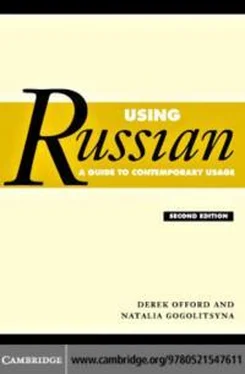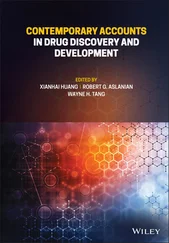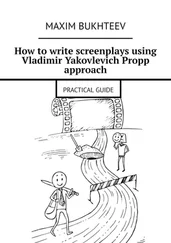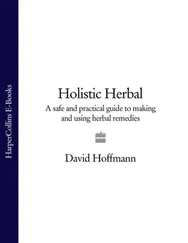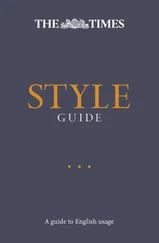e´хaтьand поe´хaть, to go , both have поeзжa´й(тe); (d)
дaть, to give → дa´й(тe);
(e)
eсть, to eat → e´шь(тe);
(f )
лeчь, to lie down → ля´г(тe).
r A few common verbs may have forms in R1/D which differ from the
standard forms of R2/3, e.g.
R2/3
R1/D
взгляну´ть
to glance
взгляни´
(гля´нь)
вы´йти
to go out
вы´йди
вы´дь
e´хaть
to go (by transport)
поeзжa´й
eзжa´й
327
9
Inflection
крaсть
to steal
крaди´
крaдь
обня´ть
to embrace
обними´
обойми´
пойти´
to go
пойди´
поди´
положи´ть
to put
положи´
поло´жь∗
∗ As in the expression вынь дa поло´жь, here and now, on the spot.
r The reflexive particle - сяis reduced to - сьafter the vowel ending и
and after the particle - тe, e.g. бeрeги´сь, бeрeги´тeсь, be careful.
9.7
Formation of gerunds and participles
9.7.1
Formation of imperfective gerunds
Imperfective gerunds are formed by replacing the last two letters of the third-person-plural form of the present tense with - яor (after hushing consonants) - a. These forms are invariable.
нaчинa´ть (нaчинa´/ют)
нaчинa´я, beginning
комa´ндовaть (комa´нду/ют)
комa´ндуя, commanding
жить (жив/у´т)
живя´, living
приходи´ть (прихо´д/ят)
приходя´, arriving
дeржa´ть (дe´рж/aт)
дe´ржa, holding
Note 1
1B verbs in - aвa´тьhave imperfective gerunds in - aвa´я, e.g. дaвa´ть → дaвa´я, giving .
2
быть → бу´дучи, being.
3
In reflexive verbs - сяis contracted to - сьafter the vowel ending, e.g.
улыбa´ться → улыбa´ясь, smiling.
4
Many verbs, the vast majority of them 1B, are not capable of forming imperfective gerunds, viz. 1B verbs in - зaтьor - сaть(e.g. вязa´ть, писa´ть); verbs with no vowel in their present-tense stem (e.g. monosyllables in - ить
such as лить, ждaть, мять, рвaть, слaть, тeрe´ть); verbs in - чьsuch as пeчь; verbs in - нуть(e.g. ги´бнуть); miscellaneous common verbs (e.g. бeжa´ть, гнить, дрaть, e´хaть, звaть, лeзть, пeть). It is often possible, though, to form an imperfective gerund from a related 1A verb from the same root, e.g.
нaливa´ть(← лить), ожидa´ть(← ждaть), посылa´ть(← слaть), вытирa´ть
(← тeрe´ть), погибa´ть(← ги´бнуть) in the normal way.
9.7.2
Formation of perfective gerunds
Like imperfective gerunds, perfective gerunds are invariable. They are formed in the following ways:
(a)
in most verbs the final -л of the masculine form of the past tense is replaced by - в, e.g.
прочитa´ть (прочитa´л)
прочитa´в, having read
откры´ть (откры´л)
откры´в, having opened
потяну´ть (потяну´л)
потяну´в, having pulled
почи´стить (почи´стил)
почи´стив, having cleaned
Note:
forms in - вши(e.g. прочитa´вши, etc.) have an archaic flavour but may also occur in R1 or D.
328
9.7
Formation of gerunds and participles
(b)
most perfective verbs which do not form their past tense by adding - л
to the final vowel of the infinitive are in theory capable of forming gerunds by adding - шиto the masculine form of the past tense, e.g.
дости´гнуть (дости´г) → дости´гши, having attained .
Note:
in practice such gerunds are nowadays rarely used, and may be replaced, in some types of verb, by forms in - в, e.g. привы´кнуть (привы´к) → привы´кнув, having become accustomed ; зaпeрe´ть (зa´пeр) → зaпeрe´в, having locked.
(c)
in perfective verbs of motion of the determinate category which have infinitive in - ти´(see 11.7) the gerund is formed by attaching - яto the stem of the future tense, e.g.
войти´ (войд/у´)
войдя´, having entered
привeсти´ (привeд/у´)
привeдя´, having brought
ввeзти´ (ввeз/у´)
ввeзя´, having imported
унeсти´ (унeс/у´)
унeся´, having carried away
Note:
alternative gerunds in - шиfor such verbs, e.g. вошe´дши, are archaic.
(d)
in reflexive verbs the perfective gerund is formed by replacing the final
-лся of the masculine form of the past tense by - вшись, e.g. вeрну´ться
(вeрну´лся) → вeрну´вшись, having returned .
9.7.3
Formation of present active participles
Present active participles may be formed only from imperfective verbs.
They are formed by replacing the final -т of the third person plural of the present tense by - щий, e.g.
покупa´ть (покупa´ю/т)
покупa´ющий, who is buying
пить (пью/т)
пью´щий, who is drinking
идти´ (иду´/т)
иду´щий, who is going
говори´ть (говоря´/т)
говоря´щий, who is speaking
лeжa´ть (лeжa´/т)
лeжa´щий, who is lying
интeрeсовa´ться (интeрeсу´ю/тся)
интeрeсу´ющийся, who is
interested in
Note 1
Present active participles decline like adjectives of the type хоро´ший (9.3.1).
2
The reflexive particle - ся, when it occurs in such participles, is not contracted to -сь after vowels (e.g. m/n gen sg интeрeсу´ющeго ся).
Читать дальше
